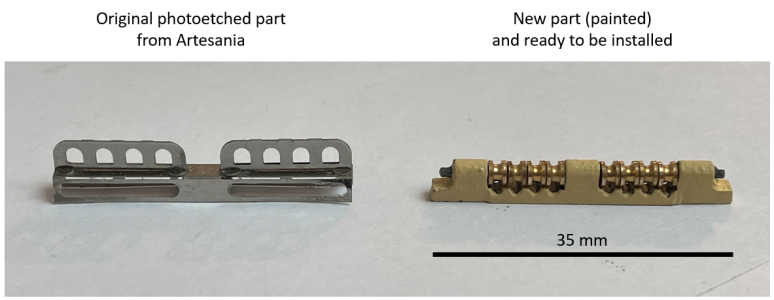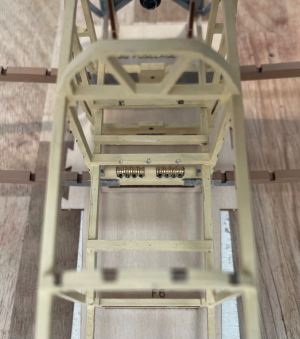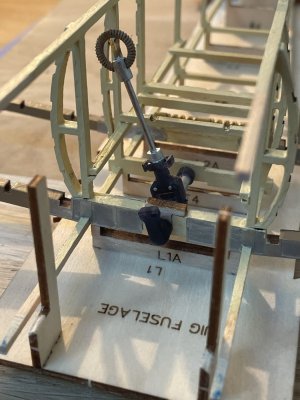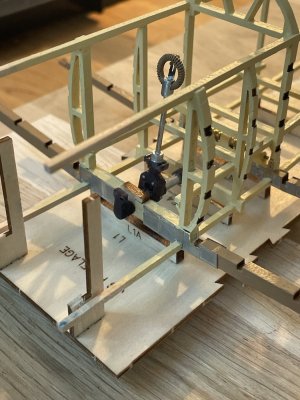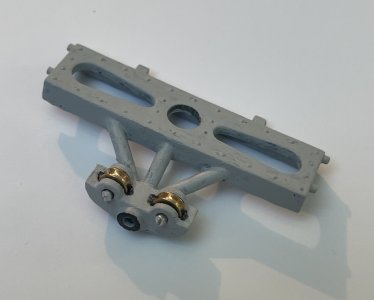Yes, I'm afraid it was moveable and it doesn't look much like the Artesania one. I will try and get a picture of mine if you like ?
-

Win a Free Custom Engraved Brass Coin!!!
As a way to introduce our brass coins to the community, we will raffle off a free coin during the month of August. Follow link ABOVE for instructions for entering.
-
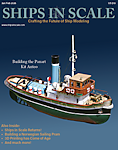
PRE-ORDER SHIPS IN SCALE TODAY!
The beloved Ships in Scale Magazine is back and charting a new course for 2026!
Discover new skills, new techniques, and new inspirations in every issue.
NOTE THAT OUR FIRST ISSUE WILL BE JAN/FEB 2026
- Home
- Forums
- Ships of Scale Build Logs
- Super Detailing Static Models / Other Genres
- Super Detailing Static Models
You are using an out of date browser. It may not display this or other websites correctly.
You should upgrade or use an alternative browser.
You should upgrade or use an alternative browser.
Sopwith Camel – modified Atesania 1:16 – fully functional –
Thanks! That would be very nice to see some pictures so I can see how the mechanism is on that version of the aircraft.Yes, I'm afraid it was moveable and it doesn't look much like the Artesania one. I will try and get a picture of mine if you like ?
I tried really hard to get some pictures but without much success. The top of the mechanism has a very strong 'bungee' at the top which attached to the frame. The bottom/middle part is bound to the frame with cord quite tightly but, with the bungee allows for a small amount of up and down movement. I hope that helps.
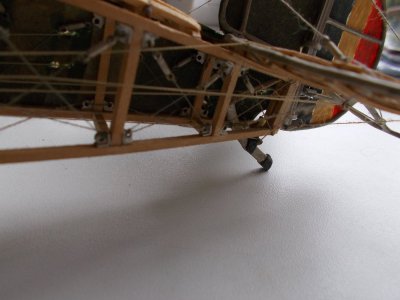
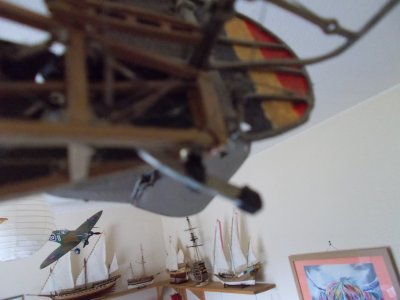


Thanks for the images.I tried really hard to get some pictures but without much success. The top of the mechanism has a very strong 'bungee' at the top which attached to the frame. The bottom/middle part is bound to the frame with cord quite tightly but, with the bungee allows for a small amount of up and down movement. I hope that helps.
View attachment 502308
View attachment 502309
I made a slight modification to the fuselage to accommodate the new control stick mechanism. Specifically, I removed material from the L1A wooden piece (as indicated by the dashed lines in the image below) and replaced it with a T-shaped part designed to hold the horizontal axis of the new control stick.
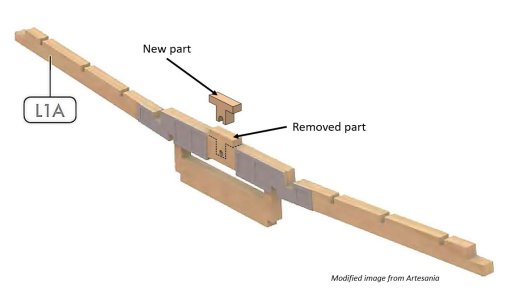
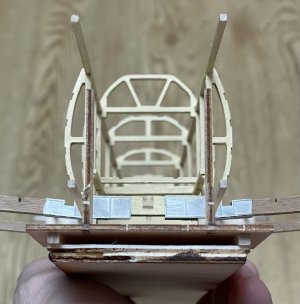
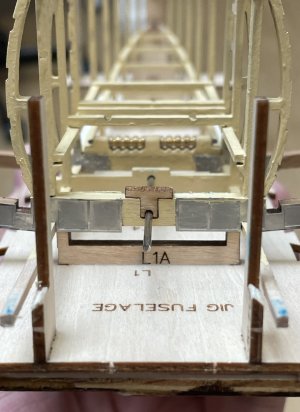



Last edited:
In the Artesania kit, all control surfaces—including the ailerons, rudder, and elevator—are fixed in place and cannot pivot as they should. To achieve proper movement, I needed to modify the design and implement a functional hinging mechanism.
Also, all the wires (threads) that command the motion of ailerons, rudder, and elevator should be fully functional.
The original pulleys in the wings of the Artesania model, which are supposed to transmit control at approximately a right angle, are completely non-functional and need to be replaced.
Below is an overview of how Artesania’s stock pulleys are constructed. They are made from photo-etched parts and have dimensions of approximately 6.2 x 6.3 mm. My goal is to find fully functional pulleys with similar dimensions to fit within the dedicated space in the wings.
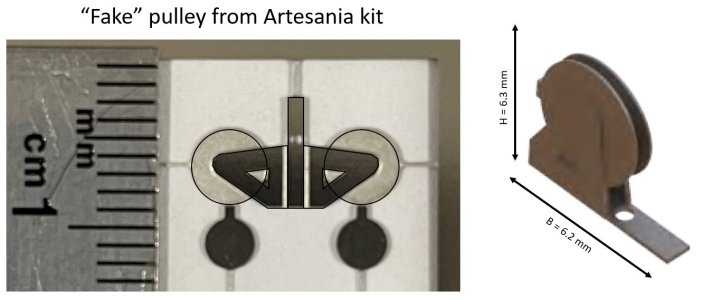
Also, all the wires (threads) that command the motion of ailerons, rudder, and elevator should be fully functional.
The original pulleys in the wings of the Artesania model, which are supposed to transmit control at approximately a right angle, are completely non-functional and need to be replaced.
Below is an overview of how Artesania’s stock pulleys are constructed. They are made from photo-etched parts and have dimensions of approximately 6.2 x 6.3 mm. My goal is to find fully functional pulleys with similar dimensions to fit within the dedicated space in the wings.

After researching alternatives, I found a suitable pulley system from Amati. The Amati pulleys feature a frame made of photo-etched brass, with both the pulley wheel and the axis also crafted from brass. However, the overall dimensions of these pulleys were slightly larger than the Artesania ones, requiring some modifications to fit properly within the wing's designated space.

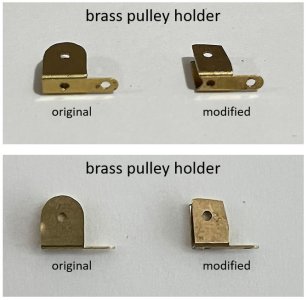
One key issue was the diameter of the brass pulley wheels. The stock Amati pulleys come with a 6 mm diameter wheel, which was too large for my needs. To resolve this, I replaced them with 5 mm diameter pulleys, ensuring a better fit while maintaining full functionality.
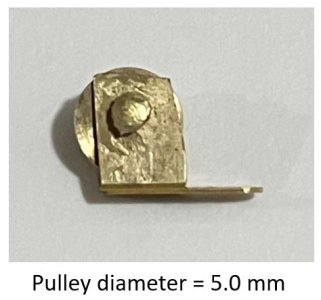
Here is the new pulley in place in the wing.
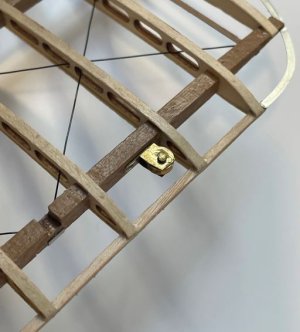


One key issue was the diameter of the brass pulley wheels. The stock Amati pulleys come with a 6 mm diameter wheel, which was too large for my needs. To resolve this, I replaced them with 5 mm diameter pulleys, ensuring a better fit while maintaining full functionality.

Here is the new pulley in place in the wing.

Last edited:
this is your wire for your rigging. This stuff is going to last,,, and it normally has a breaking strength in the 20-50 psi range. Its strong enough that the Federal level requires you to use break away clasp connectors when making jewelry with it for children. That anti choking thing.
May not be scale, but these options are 7 strands and you could try to do a real eye splice if you can see stuff that small.
And its an option for modern working ships that i havent seen discussed on a modeling forum before.
I’ve found that the black plastic/nylon threads provided by Artesania for simulating the control cables are too elastic and fragile. I’ve tested a material that’s much less stretchy and much more resistant to tension, but I’m still exploring other options. The one you’re suggesting could be a strong contender. I need to consider factors like low elasticity, high tensile strength, minimal thread diameter, and low rigidity.
this is your wire for your rigging. This stuff is going to last,,, and it normally has a breaking strength in the 20-50 psi range. Its strong enough that the Federal level requires you to use break away clasp connectors when making jewelry with it for children. That anti choking thing.
May not be scale, but these options are 7 strands and you could try to do a real eye splice if you can see stuff that small.
And its an option for modern working ships that i havent seen discussed on a modeling forum before.
Would fishing line be any good? Also I have found 'Gutterman' extra strong thread (available though Amazon) to be invaluable for rigging. It is very strong and doesn't stretch. Not too thick either so that might work.
go to the beadelon website, they have a 49 strand version that comes as small as .38mm that has the bestest flexibility.I’ve found that the black plastic/nylon threads provided by Artesania for simulating the control cables are too elastic and fragile. I’ve tested a material that’s much less stretchy and much more resistant to tension, but I’m still exploring other options. The one you’re suggesting could be a strong contender. I need to consider factors like low elasticity, high tensile strength, minimal thread diameter, and low rigidity.
- Joined
- Dec 3, 2022
- Messages
- 1,547
- Points
- 488

go to the beadelon website, they have a 49 strand version that comes as small as .38mm that has the bestest flexibility.
Astonishing!



